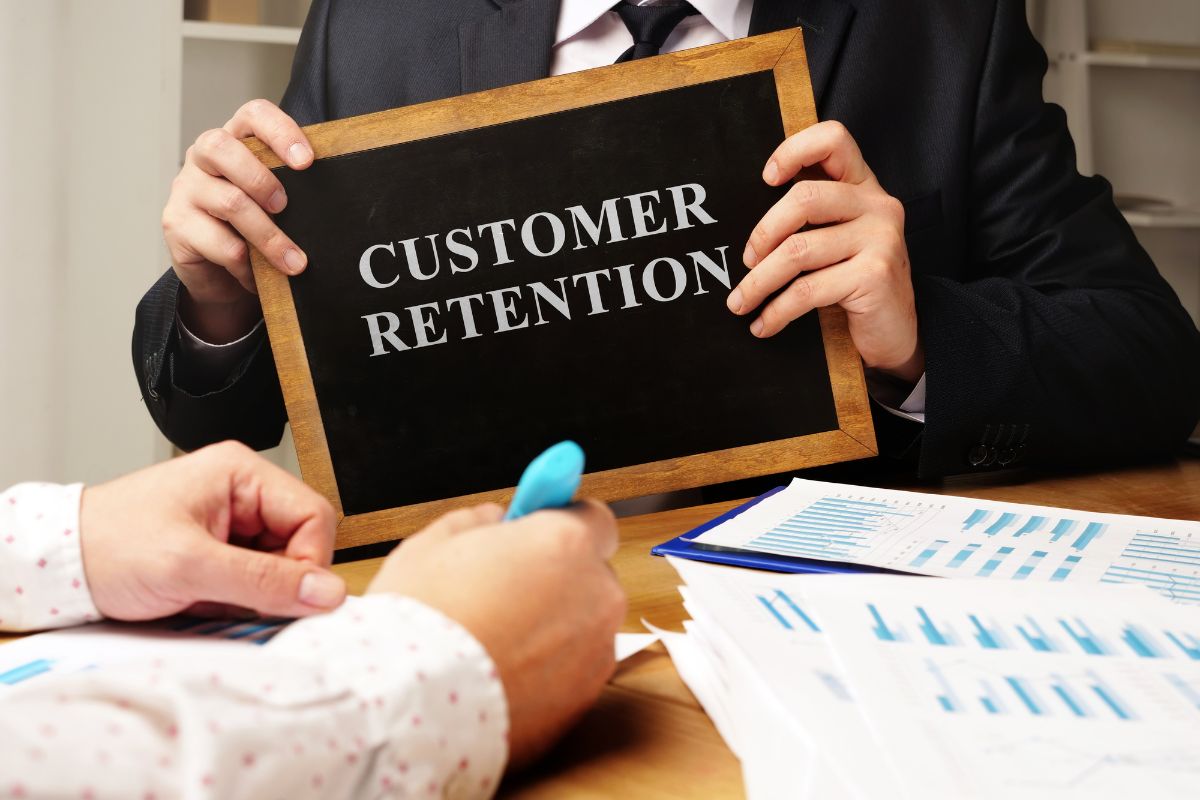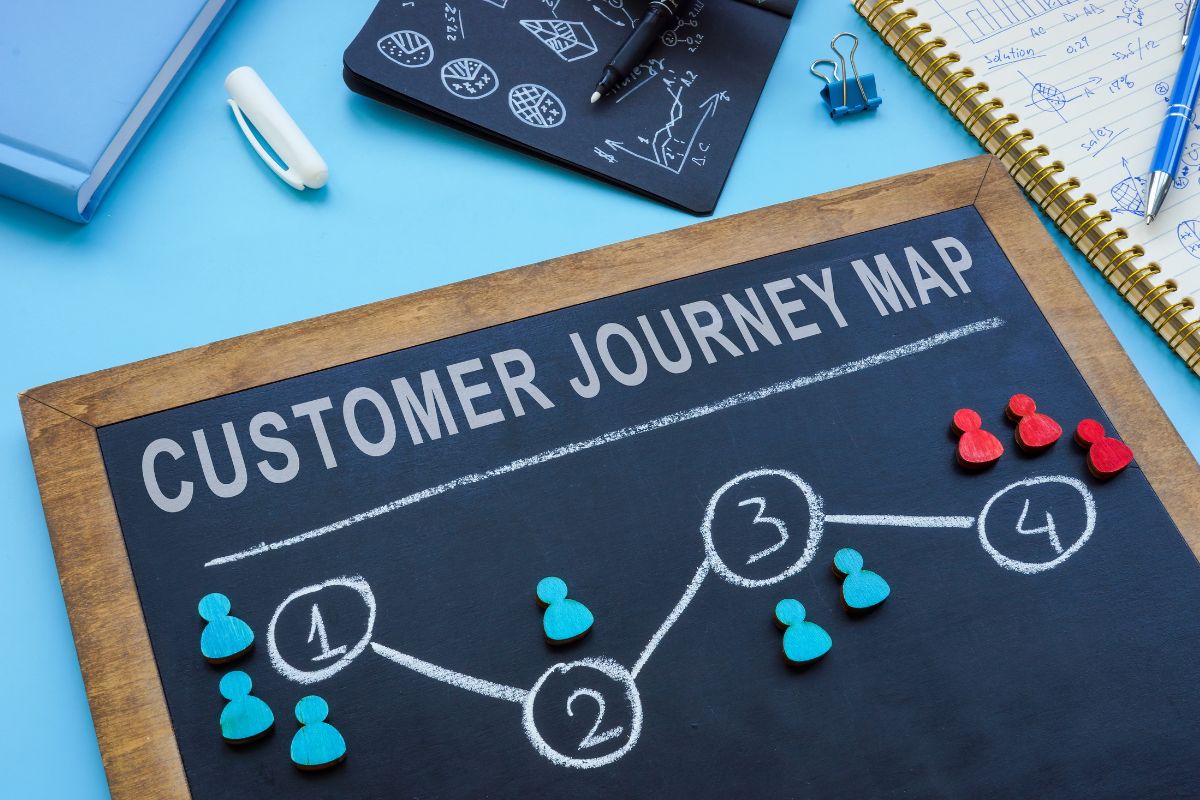Sometimes businesses fail to realize that just because a customer is buying your product or using your service doesn’t mean they will build a long-term relationship with you.
Customer relationships are built over time.
Building good relationships with customers helps you keep your customer retention rates higher.
Today, we will be discussing customer retention statistics and how businesses can improve for higher customer retention.
Overall, you should want to constantly improve your customer engagement, experience, and satisfaction to keep them coming back for more.
This is more than having an amazing product. It’s also about building amazing relationships with customers.
Getting customers to come back regularly is what customer retention is, but it can be a tricky part of business.
Regardless of your industry or niche, it’s likely that you’ll have a lot of competition, which requires you to go above and beyond the rest.
The following data will give you enough information to help you improve and keep your customers.
Post Contents
- 1 Key Statistics
- 2 Top Customer Retention Statistics in 2024
- 2.1 1. Across Every Industry, the Average Customer Retention Rate Is 75.5%.
- 2.2 2. The Top Five Companies Among Industries Have a Customer Retention Rate Average of About 94%.
- 2.3 3. Dun & Bradstreet Says that 65% of A Company’s Business Is Generated by Its Current Customers.
- 2.4 4. 80% of A Business’ Future Revenues Will Be Generated by Only 20% of Current Customers.
- 2.5 5. 50% of Existing Customers Are More Apt to Buy New Products.
- 2.6 6. A Small 5% Increase in Customer Retention Can Boost Company Profits by 75%.
- 2.7 7. 82% of Businesses Say that Customer Retention Is Cheaper than Acquisition.
- 2.8 8. A Company’s Top 1% of Loyal Repeat Customers Spends 5 Times More per Order.
- 2.9 9. 65% of Companies Said They Have a Dedicated Department that Focuses on Customer Retention and Loyalty.
- 2.10 10. 89% of Companies View Customer Experience as A Major Element for Driving Customer Retention.
- 2.11 11. 44% of Companies Are Focused Mostly on Customer Acquisition.
- 2.12 12. 45% of People Who Dine in Restaurants Say They Will Eat There Again if They Are Part of A Loyalty Program.
- 2.13 13. 80% of Customers Are More Apt to Become Repeat Customers when They Belong to A Loyalty Program.
- 2.14 14. the Average American Consumer Belongs to 16.6 Loyalty Programs.
- 2.15 15. 47% of Companies Say Their Main Goal of A Loyalty Progra Is to Boost Loyal Customer Spending.
- 2.16 16. 89% of Marketers Rely on Email Marketing to Boost Customer Retention in The United States.
- 2.17 17. 63% of U.S. Marketers Use Social Media to Drive Customer Retention.
- 2.18 18. 58% of Marketers Claim that SMS Marketing Texts Re-Engage Former Customers.
- 2.19 19. 39% of Marketers Claim that Web and Mobile Push Notifications Aid in Customer Retention Efforts.
- 2.20 20. 68% of Customers Say They Leave a Company when They Are Not Happy with How They Are Treated.
- 3 FAQs
- 4 Conclusion
- 5 Sources
Key Statistics
- Across every industry, the average customer retention rate is 75.5%.
- The top five companies among industries have a customer retention rate average of about 94%.
- Dun & Bradstreet says that 65% of a company’s business is generated by its current customers.
- 80% of a business’ future revenues will be generated by only 20% of current customers.
- 50% of existing customers are more apt to buy new products.
- A small 5% increase in customer retention can boost company profits by 75%.
- 82% of businesses say that customer retention is cheaper than acquisition.
- A company’s top 1% of loyal repeat customers spends 5 times more per order.
- 65% of companies said they have a dedicated department that focuses on customer retention and loyalty.
- 89% of companies view customer experience as a major element for driving customer retention.
Top Customer Retention Statistics in 2024

1. Across Every Industry, the Average Customer Retention Rate Is 75.5%.
Zippia reveals that the average customer retention rate is 75.5% across all sectors.
The industry with the highest global customer retention rate includes professional and media services with an 84% customer retention rate.
This shows us how important customer service and relations are to consumers all over the globe.
(Zippia)
2. The Top Five Companies Among Industries Have a Customer Retention Rate Average of About 94%.
According to Survey Sparrow and HubSpot, in many industries, the top five “players” across industry sectors have a customer retention rate of about 94% on average.
It also seems to be easier for certain industries to achieve higher retention rates as we will learn from these statistics.
(HubSpot Blog 2023, Survey Sparrow)
3. Dun & Bradstreet Says that 65% of A Company’s Business Is Generated by Its Current Customers.
According to a Dun & Bradstreet report, 65% of an organization’s business is generated by its existing customer base.
The Customer Service Institute researched and came to this finding, and it was reported by Dun & Bradstreet and other organizations.
The cost of acquiring new customers is high, which makes customer retention an essential part of day-to-day business dealings.
(Dun & Bradstreet)
4. 80% of A Business’ Future Revenues Will Be Generated by Only 20% of Current Customers.
The Gartner Group revealed statistics that showed 80% of future business revenue comes from only 20% of a company’s existing customer base.
According to Investopedia, this is related to the 80-20 rule (the Pareto Principle) that states “80% of outcomes result from 20% of all inputs for any given event.”
This is a principle that proves itself many times over.
(Forbes, Investopedia)
5. 50% of Existing Customers Are More Apt to Buy New Products.

Not only are existing customers 50% more apt to buy a new product from a business, but they are also more apt to spend 31% more than new customers.
This concept fits well with the idea of a strong brand loyalty that comes from a good customer retention program.
(Zippia)
6. A Small 5% Increase in Customer Retention Can Boost Company Profits by 75%.
Data shows that just a small 5% boost in customer retention can result in an increase of 75% in profits.
Moreover, the profit increase can range from between 25% and 95% when you increase your customer retention by 5%.
This includes 65% of company sales that come from repeat customers.
(Business News Daily, SuperOffice)
7. 82% of Businesses Say that Customer Retention Is Cheaper than Acquisition.
It’s less expensive to retain your existing customers than it is to gain new ones. In fact, 82% of companies surveyed agree that it’s true.
A 2015 article in Forbes confirms this data gotten from an eConsultancy report released that year.
Data like this is essentially evergreen.
(Forbes²)
8. A Company’s Top 1% of Loyal Repeat Customers Spends 5 Times More per Order.
Statistics show that a company’s top 1% of repeat customers spend 5 time more per order than the other 99% of their customers.
Also, when a customer has been buying and engaging with a company for at least a year and a half (30 months), they are apt to spend 67% more than they did on their first purchase.
(Conversational)
9. 65% of Companies Said They Have a Dedicated Department that Focuses on Customer Retention and Loyalty.
In a Loyalty360 survey commissioned by SAS it was revealed that 65% of company owners who were surveyed have a department dedicated solely to customer retention and loyalty.
Another 13% said they plan to implement a dedicated function for customer retention and loyalty.
In contrast, 20% said they had no plans to implement this kind of department and 2% said they don’t know.
(Loyalty360)
10. 89% of Companies View Customer Experience as A Major Element for Driving Customer Retention.

A survey revealed that 89% of companies view customer experience as a major element for driving customer retention and loyalty.
Another 76% of companies responded that they view CLV (customer lifetime value) as a focus for their business.
All these respondents are correct.
(Invespcro)
11. 44% of Companies Are Focused Mostly on Customer Acquisition.
Even though it’s well-known that it’s cheaper to retain customers than it is to acquire new customers, 44% of companies still focus mostly on customer acquisition.
In contrast, only 18% of companies focus on customer retention.
In other statistics, 30% of agencies and 40% of businesses give equal focus to customer retention and customer acquisition.
(Invespcro)
12. 45% of People Who Dine in Restaurants Say They Will Eat There Again if They Are Part of A Loyalty Program.
In a Hospitality Technology Customer Engagement Technology Study, 45% of people who eat in restaurants said they will choose a restaurant based on if they belong to the establishment’s loyalty program.
This shows that loyalty programs work well for repeat business which correlates with customer retention.
(Hospitality Technology)
13. 80% of Customers Are More Apt to Become Repeat Customers when They Belong to A Loyalty Program.
The significance of loyalty programs is made obvious by this data.
With 80% of customers saying they are more apt to become repeat buyers if they belong to a loyalty program, why are more businesses implementing such programs? Remember that 80% of company profits come from 20% of its loyal customers.
(Spurr)
14. the Average American Consumer Belongs to 16.6 Loyalty Programs.
Statista reveals data from a U.S. survey of consumers that shows American consumers belong to an average of 16.6 loyalty programs as of 2022.
However, these same consumers actively use fewer than half of these programs.
That means out of 16.6 loyalty programs, the average American consumer only uses about 8.3 of them.
(Statista)
15. 47% of Companies Say Their Main Goal of A Loyalty Progra Is to Boost Loyal Customer Spending.

There are several reasons companies implement loyalty programs, but the number one reason at 47% is to boost existing customer spending.
In other words, they want customers to keep coming back for more and spending more on their products and services.
Only 10% of companies implement loyalty programs for new customer acquisition.
(Loyalty360)
16. 89% of Marketers Rely on Email Marketing to Boost Customer Retention in The United States.
In a world where some people think that email and email marketing is all by dead, 89% of marketers today rely on this method to increase customer retention in the United States, according to Statista.
(Statista², WebFX)
17. 63% of U.S. Marketers Use Social Media to Drive Customer Retention.
While email marketing is the number one preference of marketers in the United States for driving retention, 63% use social media to drive customer retention.
Other marketing methods used for customer retention include direct mail (55%), and general online marketing (49%).
Paid social media advertising (42%) and SEO (41%) methods are also used by marketers to encourage customer retention.
(TrueList)
18. 58% of Marketers Claim that SMS Marketing Texts Re-Engage Former Customers.
When a customer lapses in engagement and activity with a company, 58% of marketers say that SMS text messaging can help re-engage them and encourage them to come back.
This is another effective customer retention method, especially when a customer has not engaged in a while.
(Startupbonsai)
19. 39% of Marketers Claim that Web and Mobile Push Notifications Aid in Customer Retention Efforts.
Another way to further your customer retention efforts is to utilize web and mobile notifications.
It can help remind an existing customer to come back or even encourage a lapsed customer to return. Notifications act as effective reminders for customers whether they have stopped engaging, or just forgot you were available.
(SEMRush)
20. 68% of Customers Say They Leave a Company when They Are Not Happy with How They Are Treated.

Being unhappy with how they are treated can happen a single time which can cause a customer to quit spending money with a company.
In fact, 68% of customers say they leave because they aren’t happy with how they are treated.
Even a single incident can impact how a customer views your company.
You can’t afford for customers to become upset with how they are treated by you or your representatives.
(Salesforce)
FAQs
What is Customer Retention?
Customer retention relates to businesses and how they want to keep their customer base.
There are customer retention strategies that come from research and planning that help businesses with customer retention.
The idea is to keep your customers engaged and loyal by fostering positive customer relationships.
Some goals of customer retention are to reduce customer churn, encourage repeat business, and to promote brand advocacy.
What is so Important About Customer Retention?
Customer retention is important to businesses for these reasons:
Increased Profits: Customers who are loyal will spend more money in the long term, which results in an increase in profits.
Marketing Costs Savings: When you retain your current customer base you will spend less on marketing to gain new customers.
Enhanced Customer Lifetime Value (LTV): The longer you can retain a customer, the more money you can expect over the customers’ lifetimes.
Building Brand Loyalty: Long term customers add value to your business and profitability due in part to their loyalty to the brand.
What are Some Effective Customer Retention Strategies?
Businesses who want to keep their customers for the long term will use these strategies:
Deliver Superior Customer Service: Going the extra mile for customers adds to their satisfaction and overall customer experience.
Being responsive to their inquiries and resolving problems efficiently and swiftly go a long way to improving customer retention.
Offer a Loyalty Program: Companies that offer loyalty programs are successful at customer retention, which leads to repeat business.
Personalized Customer Experience: Learn and understand what your customers need and want helps you to tailor their customer experience via services and products to their individual needs.
Engage Customers: Engaged customers are more likely to become loyal and refer new business to you.
Engaging customers today involves social media marketing, email marketing, and other avenues of engagement.
Feedback is Important: It’s important to get feedback from your existing customers.
Knowing what they are thinking helps you find ways to improve their experience with your company.
What is Customer Churn?
Customer “churn”, or customer churn rate is calculated by dividing how many customers a business had at the end of the period by how many you had at the start of the period and then you multiply that number by 100.
This equation will provide you with a percentage representing customer churn rate for a business during a specific period.
For reference, if you had 3,500 customers on May 1 at midnight and on May 31 at 11:59 p.m. you had 3,200 customers, you would figure your customer churn rate this way:
3200/3500 = 0.91 (3200 divided by 3500 equals 0.91)
0.91 x 100 = 91%. (0.91 times 100 = 91%)
Therefore, in this case your customer churn rate for the month of May would be 91%.
Keep in mind that the higher the customer churn rate is the more customers a business is losing.
That should prompt a business to do better with their customer service and customer experience overall.
Customer churn can occur due to poor customer service (experience), lack of personalization, lack of competition, and high prices.
Don’t let these things increase your customer churn.
How Can You Track Customer Retention?
Most businesses use a customer relationship management program (CRM) to track their customer retention rate.
This kind of software is there to help monitor and track customer retention.
What Metrics are Involved for Measuring Customer Retention Rates?
Companies can measure customer retention via these metrics:
Customer Churn Rate: This metric tells you how many customers have quit buying from you over a period.
Customer Lifetime Value: This metric provides you with data that relates to how much you can expect a customer to spend over their lifetime with your company.
Net Promoter Score (NPS): This is how you learn how likely customers are to recommend your company and offers to others.
Customer Satisfaction Score (CSAT): CSAT may seem self-explanatory, but it’s how you measure customer satisfaction related to your services and products.
Conclusion
These statistics show how imperative it is to engage with customer retention methods.
It’s cheaper to keep customers than it is to get new ones.
The fact that existing customers are more likely to spend more than a new customer should encourage businesses to develop better retention solutions.
Customer service, the customer experience, and customer relations all correlate with customer retention.
One interaction that is unsatisfactory could cause a customer never to return and that’s bad for business and the bottom line.
We have provided you with data that shows you how to better retain customers and what professional marketers say about doing just that.
We also shared a few ways to boost customer retention and FAQs that answer questions you may not have known.
Based on these statistics, how will you respond to handling customer retention, customer service, and customer relations in the future?
We hope these customer retention statistics have been helpful to you in improving your own customer retention rates.






























